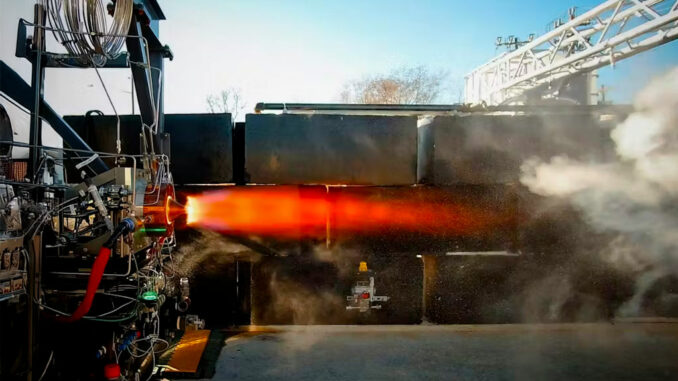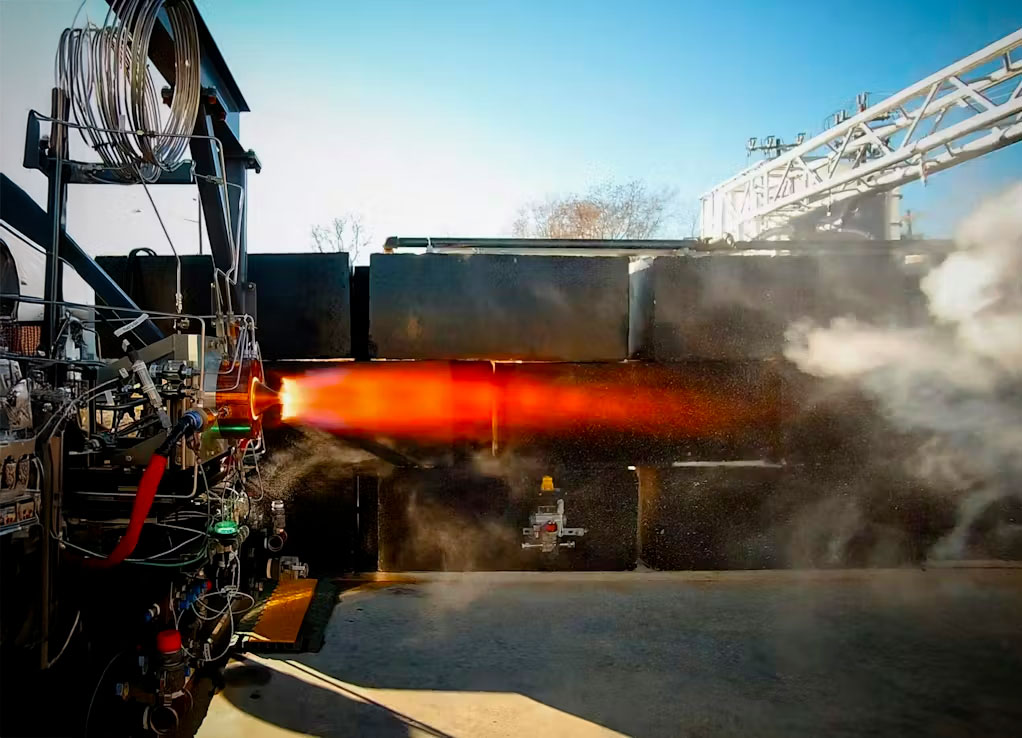
Venus Aerospace’s VDR2, an engine combining an RDRE and a ramjet, propels drones and aircraft at speeds of up to Mach 6.
Houston-based Venus Aerospace has developed the VDR2 hypersonic engine, designed to propel drones and aircraft at speeds of up to Mach 6 (around 7,350 km/h). This innovative engine integrates a rotary detonation rocket engine (RDRE) for high thrust, coupled with a ramjet for efficient high-altitude cruising. The combination of these technologies enables continuous operation from take-off to hypersonic speeds, without complex mechanical systems. The VDR2 is scheduled to equip Venus Aerospace’s hypersonic test drone as early as 2025.
A major innovation in hypersonic propulsion
Venus Aerospace has unveiled the VDR2, an engine designed to revolutionize the field of hypersonic propulsion. This engine is capable of propelling aerial vehicles at speeds of up to Mach 6, or six times the speed of sound. At this speed, a transatlantic flight could be completed in less than an hour.
The VDR2 incorporates two cutting-edge technologies:
- Rotary Detonation Rocket Engine (RDRE): This engine delivers high thrust by exploiting continuously rotating detonation waves in the combustion chamber. This increases energy efficiency and reduces fuel consumption.
- Ramjet: This provides efficient propulsion in the cruise phase at high altitude, by compressing incoming air at supersonic speeds with no moving parts, thus simplifying design and maintenance.
The integration of these two technologies enables the VDR2 to operate without the addition of complex mechanical systems, reducing overall weight and improving reliability. In addition, the absence of moving parts in the ramjet minimizes the risk of mechanical failure.
Strategic collaboration with Velontra
For the development of the VDR2, Venus Aerospace has teamed up with Velontra, a company specializing in high-speed air combustion. This collaboration aims to optimize engine performance by combining Venus’ expertise in hypersonic propulsion with Velontra’s expertise in supersonic combustion.
Dr. Andrew Duggleby, co-founder of Venus Aerospace, said at the Up.Summit presentation: “This engine makes hypersonic economics a reality”. For his part, Eric Briggs, COO at Velontra, expressed his enthusiasm for the partnership, underlining the importance of bringing to life a concept that, until now, has only existed in theoretical textbooks.
This synergy between the two companies should speed up the process of developing and commissioning the VDR2, with flight tests scheduled for 2025 on Venus Aerospace’s hypersonic drone.

Potential applications and business prospects
The VDR2 engine is intended to power not only drones, but also hypersonic commercial aircraft, such as Venus Aerospace’s Stargazer M400. This aircraft is designed to cruise at Mach 4 (approx. 4,900 km/h) at an altitude of 110,000 feet (approx. 33,500 meters), with a maximum speed of up to Mach 9 (approx. 11,000 km/h).
Use of the VDR2 in the Stargazer M400 would enable commercial flights at hypersonic speeds, considerably reducing journey times. For example, a flight from Los Angeles to Tokyo could be completed in less than two hours, compared with over eleven hours with current aircraft.
The hypersonic flight market represents considerable economic potential. According to aerospace industry estimates, the market for hypersonic aircraft could reach several billion euros over the next few decades, with applications in commercial transport and the defense sector.
Partnership with NASA for advanced testing
Earlier this year, Venus Aerospace announced a partnership with NASA to test RDRE engines in conditions close to actual flight. During this test campaign, the Venus-designed engine injector achieved the longest sustained detonation runtime, with 4 minutes of testing under real conditions. By comparison, most tests of this type last only 1-2 seconds.
This achievement represents a significant step forward, reducing the risks associated with RDREs and paving the way for in-flight demonstrations. NASA is considering the use of RDREs for space applications such as lunar and Martian landers, in-orbit operations and deep space exploration missions.
Consequences for the aerospace and defense industry
The introduction of VDR2 could transform the aerospace and defense landscape. Hypersonic engines offer strategic advantages, particularly in terms of deployment speed and rapid reaction capabilities. For military applications, this means increased possibilities for reconnaissance, surveillance and intervention missions.
On the commercial side, the development of hypersonic aircraft could revolutionize air transport, offering ultra-fast journey times and opening up new markets. However, challenges still lie ahead, notably in terms of regulation, safety and airport infrastructure suited to hypersonic operations.
Technical challenges and next steps
Despite the advances made, the development of hypersonic engines like the VDR2 involves major technical challenges. Thermal and mechanical stresses at hypersonic speeds are considerable. Heat management, material strength and combustion stability are key areas requiring in-depth research.
Venus Aerospace, in collaboration with partners such as Velontra and NASA, is pursuing research and development efforts to optimize the VDR2. Next steps include flight tests scheduled for 2025, which will be decisive in validating the engine’s performance under real-life conditions.
War Wings Daily is an independant magazine.